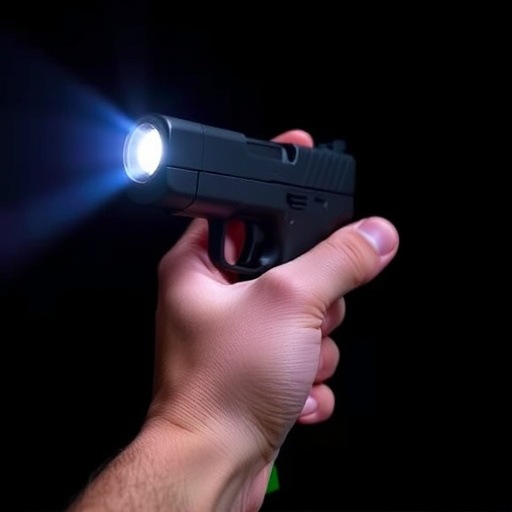Stun guns operate by delivering an electric shock that disrupts muscle control, temporarily paralyzing muscles and causing balance loss. Their effectiveness lies in brief incapacitation, enabling control or escape. Range is governed by projectile type, environmental conditions, user technique, and power source capacity. Legal frameworks vary globally, with strict guidelines for possession and deployment to ensure public safety. Understanding how stun guns work, their range limitations, and proper handling practices is crucial for safe and effective use.
Stun weapons, also known as electroshock guns or Tasers, have evolved from their traditional hand-held devices to include advanced projectile options. This article delves into the fascinating world of stun weapon technology and explores the science behind delivering powerful shocks over varying distances. We examine the factors influencing projectile range and accuracy, from cartridge design to atmospheric conditions. Additionally, we discuss legal considerations and safety measures surrounding the use of stun guns, highlighting their growing role in law enforcement and personal defense.
- Stun Weapon Technology: The Science Behind the Shock
- Projectile Range: Factors Influencing Distance and Accuracy
- Legal Considerations and Safety Measures for Stun Gun Use
Stun Weapon Technology: The Science Behind the Shock
Stun weapon technology, especially in the form of stun guns, operates on a simple yet powerful principle: delivering an electric shock to incapacitate a target temporarily. The question often arises—how does a stun gun work? Well, these devices use electrical energy to disrupt muscle control in the body, specifically targeting the nervous system. When activated, a stun gun fires a small projectile, typically a metal rod or dart, towards the intended subject. This projectile is charged with high-voltage electricity, creating an arc that delivers a strong electric pulse upon impact.
The shock caused by this arc overloads the body’s natural protective mechanisms, temporarily paralyzing muscles and causing a loss of balance and coordination. This effect is designed to stun the target for several seconds, allowing the user to gain control or escape. The technology behind stun weapons has evolved significantly, offering various range options and different projectile types to suit diverse applications, all while ensuring user safety by employing non-lethal force.
Projectile Range: Factors Influencing Distance and Accuracy
The range at which a stun weapon can effectively deploy its energy is influenced by several key factors. Understanding these elements is crucial to comprehending the capabilities and limitations of such devices, including how does a stun gun work in practice. One primary factor is the type of projectile used; whether it’s a dart, bean bag, or even a specialized ball, each design has its own trajectory and penetration characteristics that affect range. Additionally, environmental conditions play a significant role. Wind speed and direction can dramatically impact the flight path of the projectile, requiring users to account for these factors in order to maintain accuracy at longer distances.
The user’s technique also contributes to the overall range and precision. Proper training ensures that the stun weapon is deployed correctly, maximizing its effectiveness. Furthermore, the power source’s capacity and efficiency directly influence the energy delivered over distance, affecting both the projectile’s velocity and the overall stun capability at extended ranges. These factors combined determine the operational reach of stun weapons, offering insights into their practical applications in self-defense scenarios.
Legal Considerations and Safety Measures for Stun Gun Use
The use of stun weapons, including guns and hand-held devices, is regulated by local laws and regulations worldwide. Before considering the capabilities of a stun gun’s projectile range, it’s crucial to understand the legal landscape surrounding their possession and deployment. Stun guns are classified as less-lethal or non-lethal weapons, designed to incapacitate individuals temporarily without causing permanent harm. However, their use is subject to strict guidelines to ensure public safety and prevent misuse. Laws vary significantly across regions; some permit their use only by law enforcement, while others allow qualified civilians to carry them for self-defense. Understanding these legal parameters is essential before operating or carrying a stun gun, as unauthorized use can lead to severe penalties.
Safety measures are paramount when discussing stun guns, especially considering their proximity to firearms in terms of functionality. Unlike traditional firearms that project lethal force, stun guns utilize electrical current to disrupt muscular control, leading to temporary paralysis. However, this power must be handled with care to prevent accidental discharge and minimize the risk of injury. Users should undergo proper training to understand how these devices operate, including their range limitations and the need for safe handling practices. Additionally, ensuring that bystanders are aware of their activation can help reduce the potential impact on innocent people in close proximity.
Stun weapons, with their projectile range capabilities, offer a non-lethal solution for self-defense, as demonstrated by the science behind their shock technology. Understanding the factors influencing range and accuracy is key to effective deployment. Moreover, legal considerations and safety measures must be paramount when using stun guns, ensuring responsible and compliant usage. By grasping how these weapons operate and adhering to guidelines, individuals can leverage the advantages of stun gun technology for personal safety.
